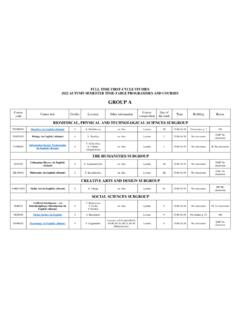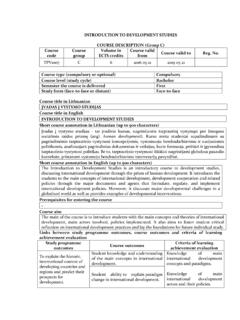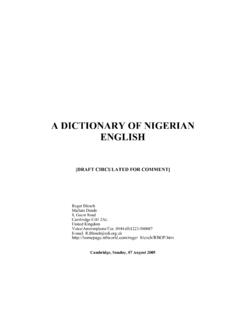Transcription of Introduction into Linguistics: A Teaching Guide
1 DALIA MASAITIEN Introduction into Linguistics: A Teaching Guide Vytauto Did iojo universitetas Kaunas, 2009 Recenzent : doc. dr. Violeta Kal dait Svarstyta Vytauto Did iojo universiteto Angl filologijos katedros pos -dyje 2009 05 11 (protokolo Nr. 6); Humanitarini moksl fakulteto tary-bos pos dyje 2009 06 25 (protokolo Nr. 6) ir rekomenduota isleisti elek-tronin versij . ISBN 978-9955-12-498-6 D. Masaitien Vytauto Did iojo universitetas 2 CONTENTSP reface ..4 Introduction ..5 Principles of Modern Morphology ..18 Syntax ..23 Glossary ..41 References ..47 3 PREFACE This Teaching aid has grown out from the course Introduction into English Linguistics which I have been Teaching at Vytautas Magnus University for a number of years.
2 Its aim is to present students with a concise and up-to-date discussion of some of the main topics that mod-ern linguistics addresses. The Teaching Guide is provided with exercises for each topic (graded from less difficult to advanced), and questions for discussion. All the exercises have been tested in class. The Teaching Guide also includes a glossary of the most important terms which stu-dents have to know and be able to use not only in this course but also in the other linguistic courses that they take in the programme of English Philology. Dalia Masaitien 4 Introduction Linguistics is the scientific study of language. Human language, understood as a systematic use of speech sounds, signs, and written symbols for communication among people, is a very complicated sys-tem, which can be analysed on different levels and from various points of view.
3 Modern linguists often adopt different perspectives on language depending on the goals of their research. It is common to distinguish between language as an individual act of speaking or writing in a par-ticular context at a given moment or in a certain social context, and language as the abstract linguistic system underlying the linguistic behaviour of a whole community of speakers. In addition, a number of separate, though often closely interrelated, branches of linguistics can be distinguished. General or theoretical linguistics tries to determine universal prin-ciples for studying languages and to describe the general features of language. Contrastive linguistics concentrates upon the differences between languages.
4 Its findings are often applied in the context of language Teaching . Comparative linguistics studies different languages looking for similar characteristics. These languages may have common historical origin though the main emphasis of the analysis is usually placed on the structural correspondences between languages under investigation. Historical linguistics analyses the development of language in time, registering the changes that have taken place in it. Applied linguistics is concerned with the application of linguistic theories and their findings in solving various language problem, mostly in the Teaching of foreign languages, studying language disorders, in translation, lexicography, and stylistics.
5 Sociolinguistics studies the relationship between language and so-ciety, taking into consideration standard and non-standard forms of lan-guage, regional and social varieties with reference to such concepts as ethnicity, social status, sex, age, etc. Psycholinguistics is a branch of linguistics which studies the rela-tionship between linguistic behaviour and the mental processes. It is interested in how mental processes influence the production and percep-tion of speech. 5 Computational linguistics uses computer techniques and applies them in automatic translation and speech analysis using corpora for large-scale statistical investigation and computational processing of spoken and written texts.
6 Developmental linguistics is concerned with the study of the ac-quisition of language by children, describing the stages and patterns of development and explaining the typical features and variations. Anthropological linguistics studies language variation and usage in relation to culture. Emphasis is often placed on the analysis of the so-called non-Western languages. The above-mentioned branches do not exhaust all the approaches to language that can be distinguished in modern linguistics, which is a vigorously developing science. Features Common to All Languages There are a lot of questions that can be asked about language, some scientific, some not. One such question is: Which is the oldest language in the world?
7 Several centuries ago, researchers were much concerned with this question, however, it does not have a reliable answer, simply because we cannot go so far into the history of humanity. Another often asked question is about the features that all natural human languages share. The American linguist Charles Hockett has pointed out a number of such properties. Here are some of them: a) all languages have vowels and consonants; b) all languages have words; c) all languages can create new words when required and modify their meanings; d) all languages are open-ended in the sense that they can produce totally new utterances which are understood by the users of the language; e) all languages can form questions; f)in all languages it is possible to talk about things and situations that are removed from the immediate situation of the speaker (this is called displacement); g) in all languages we can use hypothetical, unreal, and fictional utterances.
8 6 Thus, as we can see, human linguistic knowledge involves numer-ous different aspects. People are able to produce sounds and to under-stand the sounds produced by others, and those sequences of sounds signify meanings. The relation between the linguistic form (written or spoken word or expression) and meaning is arbitrary, there is no direct physical correspondence between a linguistic expression and the entity in the world to which that expression refers. For example, there is no explicit relationship between the English word window and the object itself. In other languages the same concept is represented differently ( langas in Lithuanian, okno in Russian, das Fenster in German, etc.)
9 There are certain words in most languages whose pronunciation to some extent suggests their meaning. These are onomatopoeic words that imitate the sounds associated with the things, creatures or actions that they refer to. For instance, meow imitates the sound made by a cat, splash imitates the sound of liquid hitting something or being moved around quickly, whoosh means to move very fast with a soft rushing sound. However, even onomatopoeic words are not exact phonetic imi-tations of natural sounds. Therefore, their forms often differ from lan-guage to language (compare the English bow-wow and the Lithuanian au-au as imitations of dog barking). All natural languages are creative, because they allow innovation in response to new experiences, situations, and scientific discoveries.
10 Creativity is a very important feature of all natural human languages. The human creative ability in language use is not just what we choose to say at a particular moment in a particular situation but also includes our understanding of a new sentence that we have never heard before. Ac-cording to Fromkin et al., the sentence Daniel Boone decided to become a pioneer because he dreamed of pigeon-toed giraffes and cross-eyed elephants dancing in pink skirts and green berets on the wind-swept plains of the Midwest will be understood by the native speakers of English. (2007: 9). Most likely, no one will believe the sentence; its logic will surely be questioned; but everyone speaking English can understand it, though it was probably never produced before.










